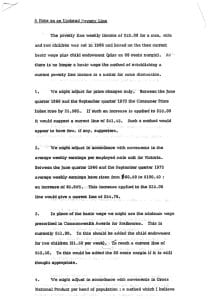Poverty Through an Archival Lens
Olivia Cobbledick, Imogen Brown, Youngeun K, & Marina Gabra
A deep dive through the dense archival material predating and informing the Henderson Poverty Report provides an insightful glance into the context, aims, and biases in which the study is grounded. Beginning in 1966, the Institute of Applied Economics embarked on the first systematic evaluation of the extent of poverty in Australia. This task grew further under the newly elected Whitlam government. Thereafter, it aimed to identify the social groups falling victim to poverty, their income needs, and related welfare and housing issues. However, the complex and often historically embedded roots of privilege and injustice shapes the definition and measurement of poverty. This becomes particularly apparent when peering into the past with contemporary eyes. Much of the material and survey format is handwritten and qualitative, allowing space for personal observations. Patriarchal, Anglo-centric, and nuclear family structures govern the measurement of ‘progress’ within these documents. With little to no mention of migrant communities hailing from non-Commonwealth countries, an ageist assessment of ability, and the prioritisation of a male ‘breadwinner’ model, these archives lay bare the cultural values and power structures existent in Australia during this period.
The Henderson Poverty Report held up the nuclear family as the idea family structure. It portrayed atypical family units, whether ‘female head’ (lack of male head) or ‘large families’ (with four or more dependent children), as more likely to experience poverty or be on the poverty line. The report went so far as to class female headed households and large families as modes of ‘disability’ which could increase one’s likelihood of experiencing poverty. This definition of ‘disabilities’ highlights the patriarchal thinking underpinning this research. Although including the voices and stories of female participants, the inclusion of female researchers with lived experiences of impoverishment may have reduced the bias exhibited by tertiary educated male researchers. These were particularly evident in case notes regarding some of the elderly women interviewed.

As per the criteria established by the Henderson Poverty Report, migrant and indigenous populations in Australia often lived below the poverty line. These communities constitute minorities, facing limited access to social security benefits and earning low incomes. In 1973, the purchasing power of non-white migrants paled in comparison to white migrants. Disparities also existed in the treatment of migrants with disabilities, with white migrants receiving higher amounts of income benefits. However, these disparities have narrowed in more recent times due to changing attitudes.

The Henderson Poverty Report did not only aim to collate data on and understand the consequences of poverty on individuals and marginalised groups in Australia. Its conceivers also lobbied the government to tackle the issue of poverty. Yet the biases of those conducting the research distorted the findings of the report, hindering the realisation of these lofty ambitions. The dismissive attitudes displayed during and after interviews with elderly women are a case in point. As are the attitudes displayed towards individuals struggling with health problems such as dementia and Alzheimers. At least one thumbnail sketch in the report described one female interviewee as “confused” and incompetent. All this is to say that in order to create sustainable societies wherein all individuals are included, empathy, objectivity, and co-production must underpin the methodology shaping such research.
Leave a Reply